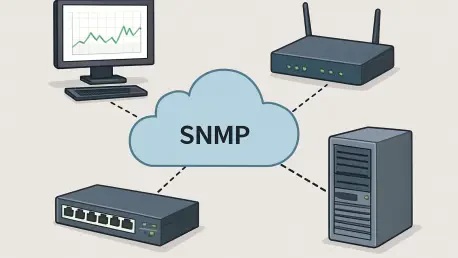In an alarming development for network administrators worldwide, a critical security flaw in a widely used network management protocol has come under attack, prompting swift action from a leading technology provider. This vulnerability, residing in the Simple Network Management Protocol (SNMP) subsystem of certain network operating systems, has been actively exploited by malicious actors, posing severe risks to enterprise and internet service provider infrastructures. Identified as CVE-2025-20352, the flaw allows attackers to trigger a system reload or, in more dangerous scenarios, execute arbitrary code with root-level access. The urgency of this situation is underscored by the fact that compromised local administrator credentials have already facilitated real-world attacks through crafted SNMP packets over both IPv4 and IPv6 networks. As this issue affects a broad range of devices with SNMP enabled, the immediate focus for many organizations must shift to understanding the scope of exposure and implementing protective measures without delay.
The implications of this vulnerability are far-reaching, given the integral role SNMP plays in network monitoring and management. Devices running specific versions of network software, such as certain models of Meraki and Catalyst switches, are particularly at risk, with fixes scheduled for upcoming releases. Beyond the primary SNMP flaw, additional security patches address over a dozen other vulnerabilities, including risks like cross-site scripting and denial-of-service attacks that could further compromise system integrity. Publicly available exploit code for some of these issues heightens the need for rapid response, as attackers can easily leverage these resources to target unpatched systems. For network teams, the challenge lies not only in applying updates but also in navigating the complexity of securing diverse hardware and software configurations across large-scale environments, all while maintaining operational continuity.
Addressing the Threat Landscape
Turning attention to mitigation strategies, it becomes evident that temporary solutions fall short of providing comprehensive protection against this exploited vulnerability. While restricting SNMP access to trusted users and specific network segments offers some defense, such measures are no substitute for the critical software updates recently released. Administrators are strongly encouraged to utilize command-line tools to audit SNMP configurations and identify at-risk devices, ensuring a proactive stance against potential breaches. The absence of effective workarounds amplifies the importance of timely patching, especially as all versions of SNMP are impacted and the potential for remote code execution looms large. Reflecting on the response to this crisis, it’s clear that swift deployment of fixes across affected systems was prioritized, alongside efforts to patch additional flaws that could have compounded the damage if left unaddressed.
Looking ahead, the focus must shift to actionable steps that prevent recurrence of such critical exposures. Organizations were urged to prioritize not only the application of updates but also the reinforcement of access controls to minimize unauthorized entry points. A key lesson from this incident was the danger posed by default or weak credentials, which often serve as a gateway for attackers. Future considerations should include regular audits of network configurations and the adoption of robust security practices to safeguard against evolving threats. By taking these steps, enterprises and service providers can better protect the backbone of global networking infrastructure, ensuring resilience against vulnerabilities that, as history showed, carried the potential for catastrophic breaches if ignored. The response to this exploited flaw stands as a reminder of the relentless pace of cyber threats and the critical need for vigilance in securing vital systems.









